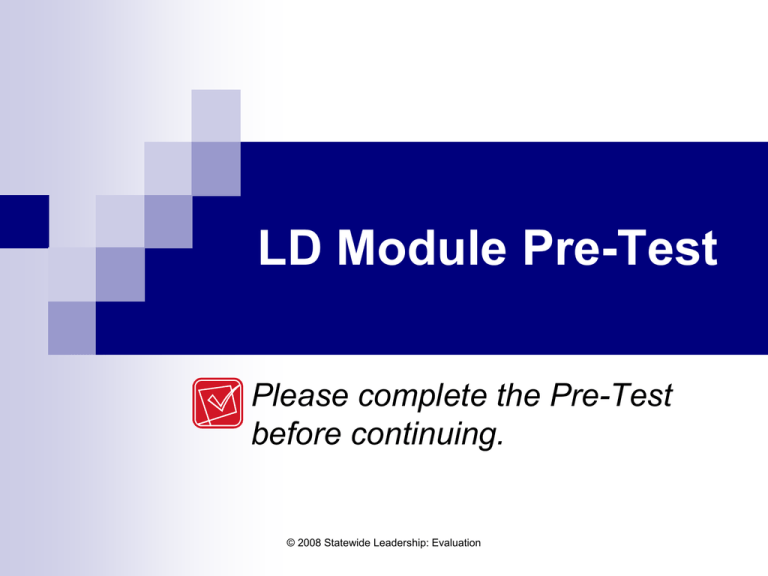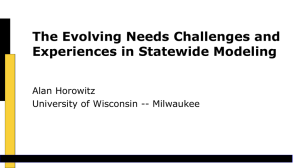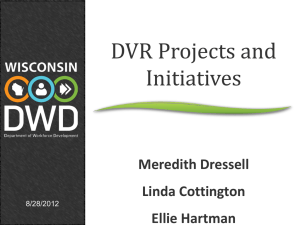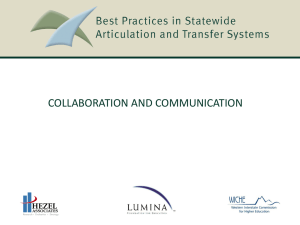Reading Disability - Region 10 Education Service Center
advertisement

LD Module Pre-Test Please complete the Pre-Test before continuing. © 2008 Statewide Leadership: Evaluation Learning Disabilities Understanding Patterns of Strengths & Weaknesses © 2008 Statewide Leadership: Evaluation “Given what we now know about LD, it is irresponsible to continue current policies that dictate inadequate early identification practices.” From: Rethinking Special Education for a New Century, Chapter 12: Rethinking Learning Disabilities G. Reid Lyon, Jack M. Fletcher, Sally E. Shaywitz, Bennet A. Shaywitz, Joseph K. Torgesen, Frank B. Wood, Ann Schulte, & Richard Olson © 2008 Statewide Leadership: Evaluation What is SLD? © 2008 Statewide Leadership: Evaluation General Principles Professionals must know: State and federal laws and regulations Definitions Exclusionary factors Criteria for identification Appropriate evaluation tools & procedures Research on learning disabilities Effective instructional practices © 2008 Statewide Leadership: Evaluation Definition (IDEA, 2004) See Section 300.8(c ) (10) SLD means a disorder in 1 or more basic psychological processes involved in understanding or in using language, spoken or written, which disorder may manifest itself in the imperfect ability to listen, think, speak, read, write, spell, or do mathematical calculations. Includes perceptual disabilities, brain injury, minimal brain dysfunction, dyslexia, and developmental aphasia. © 2008 Statewide Leadership: Evaluation Exclusionary Factors (IDEA, 2004) Excludes learning problems that are primarily the result of: • visual, hearing, or motor disabilities • mental retardation • emotional disturbance • environmental, cultural, or economic disadvantage © 2008 Statewide Leadership: Evaluation Identification of Children with Specific Learning Disabilities (SLD) IDEA 2004, Regulations See Section 300.307 • Must not require the use of a severe discrepancy between intellectual ability and achievement • Must permit the use of a process based on the child’s response to scientific, researchbased intervention • May permit the use of alternative researchbased procedures © 2008 Statewide Leadership: Evaluation Criteria for Determining SLD Does not achieve adequately for the child’s age or meet State-approved grade-level standards in one or more of the following areas when provided with learning experiences and instruction appropriate for the child’s age or State-approved grade-level standards: 8 areas to consider: Oral expression Written expression Reading fluency Mathematics calculation Listening comprehension Basic reading skills Reading comprehension Mathematics problem solving © 2008 Statewide Leadership: Evaluation Requirement to Document Appropriate Instruction and Progress Monitoring • Data that demonstrates child was provided appropriate instruction within general education settings AND • Data-based documentation of repeated assessments of achievement at reasonable intervals (formal evaluation of progress). Not SLD if achievement problem is due to lack of appropriate instruction in reading or math. © 2008 Statewide Leadership: Evaluation Criteria for Determining SLD Child’s progress in 1 (or more) of the 8 areas is not sufficient to meet age or grade-level standards when his or her response to scientific, research-based intervention is part of determination process. OR Child exhibits a pattern of strengths and weaknesses in performance, achievement, or both relative to age, grade-level standards, or intellectual development, that is determined by the group to be relevant to the identification of SLD... © 2008 Statewide Leadership: Evaluation Criteria for Determining SLD Are the findings in Factors 1 and 2 primarily a result of: Visual, hearing, or motor disability Mental retardation Emotional disturbance Cultural factors Environmental or economic disadvantage Limited English proficiency © 2008 Statewide Leadership: Evaluation Criteria for Determining SLD Three factors are needed: 1. Under-achievement …. 2. Insufficient progress OR pattern of strengths and weaknesses…. 3. Not primarily the result of…… • Exclusionary factors • Lack of appropriate instruction • Limited English proficiency © 2008 Statewide Leadership: Evaluation Appropriate Tools and Procedures Directed to use a variety of assessment tools and strategies Cannot rely on a single procedure as sole criterion Professional discretion Appropriate technical qualities Knowledge of what the test does and does not measure © 2008 Statewide Leadership: Evaluation Documentation Required for Eligibility Determination • Statement that the child has a specific learning disability • Basis for making the determination • Relevant behavior and relationship to academic functioning • Educationally relevant medical findings (if any) • Whether the child does not achieve adequately for age or meet grade level standards • Does not make sufficient progress OR exhibits a pattern of strengths and weaknesses • Determination regarding exclusionary factors © 2008 Statewide Leadership: Evaluation Status of IQ/Achievement Discrepancy Procedure for Determining LD Eligibility • May not be the sole determinant of SLD identification • May be included in the determination process • May not use simple difference method (IQ-ACH) • Must use a standard regression procedure • Usually included in conormed tests offering IQ/Achievement discrepancy calculations • Correction for regression is required when not using conormed tests that provide a predicted method © 2008 Statewide Leadership: Evaluation IQ Score Expected Achievement 130 120 At .7 130 IQ = 121 ACH At .6 130 IQ = 118 ACH 110 100 90 At .6 70 IQ = 82 ACH 80 At .7 70 IQ = 79 ACH 70 High correlation = less regression Low correlation = more regression © 2008 Statewide Leadership: Evaluation References to Consult The Statute www.nichcy.org/reauth/PL108-446.pdf http://idea.ed.gov Final Part B Regulations www.nichcy.org/reauth/IDEA2004regulations.pdf http://idea.ed.gov Texas (Commissioner’s Rules, Guidance, etc.) http://framework.esc18.net www.tea.state.tx.us/special.ed © 2008 Statewide Leadership: Evaluation Cognitive Abilities © 2008 Statewide Leadership: Evaluation Assessing Cognitive Abilities Important component in determining SLD Helpful when determining a pattern of strengths and weaknesses Provides information about intra-individual differences Diagnostic Assists value in developing appropriate interventions © 2008 Statewide Leadership: Evaluation CHC Theory: Providing a Common Taxonomy • • • • Multiple-factor view of intelligence Broad and narrow abilities Empirically-based Based on the work of Raymond Cattell, John Horn, and John Carroll = CHC theory Write a brief definition of these 7 broad CHC abilities: Crystallized Intelligence Fluid Reasoning Long-Term Retrieval Short-Term Memory Visual Processing Auditory Processing Processing Speed © 2008 Statewide Leadership: Evaluation g KABC-II Glr Long-Term Storage & Retrieval Gsm ShortTerm Memory Associative Memory Memory Span Learning Abilities Working Memory Gv Visual Processing Gf Fluid Reasoning Gc Crystallized Ability Visual Memory Induction Lexical Knowledge Spatial Relations General Sequential Reasoning General Information Free Recall Memory Visualization Quantitative Reasoning Language Development Ideational Fluency Spatial Scanning Listening Ability Originality/ Creativity Closure Speed Information About Culture © 2008 Statewide Leadership: Evaluation Stanford Binet 5 Model © 2008 Statewide Leadership: Evaluation WISC-IV MODEL FSIQ VCI PRI WMI PSI (Verbal Comprehension) (Perceptual Reasoning) (Working Memory) (Processing Speed) Similarities Vocabulary Comprehension Matrix Reasoning Block Design Picture Concepts Letter-Number Sequencing Digit Span Symbol Search Coding Supplemental Subtests Information Word Reasoning Picture Completion Arithmetic © 2008 Statewide Leadership: Evaluation Cancellation Narrow (Stratum I) Broad (Stratum II) General (Stratum III) WJ III Model G General Intelligence Gf Fluid Intelligence Gc Crystallized Intelligence GIA Glr Long-term Retrieval Gsm Short Term Memory Gv Ga Gs Visual Spatial Thinking Auditory Processing Processing Speed 69 narrow abilities found in data sets analyzed by Carroll © 2008 Statewide Leadership: Evaluation 7 CHC Factors Tests Know What Your Test Does & Does Not Measure Gc Gf Glr Gv Ga Gs Gsm KABC II SB 5 WISC IV WJ III SB5 also has a Quantitative Reasoning (QR) factor. In CHC theory, QR is a narrow ability of Gf. WISC IV places Gv and Gf in the same index (Perceptual Reasoning). © 2008 Statewide Leadership: Evaluation Abilities Defined Gc Verbal ability Gf Fluid Reasoning Glr Long-Term Retrieval Gsm Short-Term Memory Store of acquired knowledge, cultural and linguistic background Mental flexibility, deductive and inductive problem-solving abilities Process of storing and retrieving information, associative memory Immediate memory, working memory and memory span, limited capacity system © 2008 Statewide Leadership: Evaluation Abilities Defined Gv Visual Processing Ga Auditory Processing Gs Processing Speed Perception and manipulation of visual shapes or forms, visualspatial thinking Perception and processing of auditory input, phonological awareness and processing Automaticity, fluency, cognitive speed © 2008 Statewide Leadership: Evaluation Relationship to Academics Gc Verbal ability Gf Fluid Reasoning Glr Long-Term Retrieval Gsm Short-Term Memory Strong and consistent across all academics and ages Significant across all academics, especially with higher level skills Significant and moderate across all academics, especially in primary grades Significant across all academics, Working memory especially relevant to higher level skills © 2008 Statewide Leadership: Evaluation Relationship to Academics Gv Visual Processing Ga Auditory Processing Gs Processing Speed No significant relationship as measured in IQ tests currently except with higher level math. Significant relationship across all academics during early grades Significant to all academics especially in early to mid-grades © 2008 Statewide Leadership: Evaluation Oral Language © 2008 Statewide Leadership: Evaluation Importance of Oral Language •Lack of oral language and literacy exposure and interaction from birth-preschool years can result in deficits in phonemic awareness and word reading. •Impaired knowledge of sounds, vocabulary concepts, and print concepts result from lack of opportunity to listen and interact with language in multiple contexts. •Language is the foundation for learning. © 2008 Statewide Leadership: Evaluation The Effects of Weaknesses in Oral Language on Reading Growth (Hirsch, 1996) Reading Age Level 16 15 High Oral Language in 14 Kindergarten 13 5.2 years difference 12 11 Low Oral Language 10 in Kindergarten 9 8 7 6 5 5 6 7 8 9 10 11 12 13 Chronological Age © 2008 Statewide Leadership: Evaluation 14 15 16 Mind the Language Gap It is much more difficult to “close the gap” in broad knowledge and verbal skills than it is in word reading skills. Tests of reading comprehension at third grade and up are increasingly sensitive to individual differences in verbal knowledge and reasoning. © 2008 Statewide Leadership: Evaluation Importance of Phonemic Awareness A deficit in phonemic awareness is the major factor impeding development of the alphabetic principle. A deficit in phonemic awareness significantly impacts the ability to develop accurate and fluent word reading capabilities. A deficit in phonemic awareness can lead to compromised comprehension. © 2008 Statewide Leadership: Evaluation Importance of Phonemic Awareness In Kindergarten: 1. Assess phonemic awareness 2. Assess ability to name letters and numbers 3. Assess ability to provide letter sounds These are strong predictors of difficulties learning to read. © 2008 Statewide Leadership: Evaluation Developmental Sequence • Rhyming • most preschoolers and kindergartners are able to rhyme words • Count Syllables • most first graders can count syllables, blend syllables, delete part of a compound word • Perform all types of phonemic activities • most second graders © 2008 Statewide Leadership: Evaluation Rapid Automatized Naming (RAN) Ability to rapidly retrieve and label visual symbols A.) Phonological connection: RAN tasks correlate highly with other phonological skills; shows a unique causal relationship with early literacy. (Torgesen and Burgess,1998) B.) Orthographic connection: RAN related to visual and speed components needed for reading; disruption in automatic process of quick word recognition (Bowers and Wolf, 1993). © 2008 Statewide Leadership: Evaluation Early Warning Signs: Preschool • Late talking, compared to other children. • Pronunciation problems. • Slow vocabulary growth, often unable to find the right word. • Difficulty rhyming words. • Trouble learning numbers, the alphabet, days of the week. • Extremely restless and easily distracted. • Trouble interacting with peers. • Poor ability to follow directions or routines. © 2008 Statewide Leadership: Evaluation Reading © 2008 Statewide Leadership: Evaluation “Children who get off to a poor start in reading rarely catch up. We wait---they fail. But it does not have to be this way.” From: Rethinking Special Education for a New Century, Chapter 12: Rethinking Learning Disabilities G. Reid Lyon, Jack M. Fletcher, Sally E. Shaywitz, Bennet A. Shaywitz, Joseph K. Torgesen, Frank B. Wood, Ann Schulte, & Richard Olson © 2008 Statewide Leadership: Evaluation Early Identification/Intervention “Exclusion from the basic right to learn.” • Since underlying causes of early reading difficulty are similar for children regardless of placement/services, early intervention should occur through regular education. • Special education professionals should become specialists in prevention. • Without early intervention, the poor reader does not catch up (CT. study) © 2008 Statewide Leadership: Evaluation Early Warning Signs: K-4 • Slow learning connection between letters and sounds • Confuses basic words (was/saw, then/them ). • Makes consistent reading and spelling errors including letter reversals (b/d), inversions (m/w), transpositions (felt/left), and substitutions (house/home) • Transposes number sequences (14 for 41) and confuses arithmetic signs (+, -, x, /, =) • Slow recall of facts • Slow to learn new skills, relies heavily on memorization • Impulsiveness, lack of planning • Unstable pencil grip • Trouble learning about time • Poor coordination, unaware of physical surroundings, prone to accidents © 2008 Statewide Leadership: Evaluation “We estimate that the number of children who are typically identified as poor readers and served through either special education or compensatory education programs could be reduced by up to 70 percent through early identification and intervention programs.” From: Rethinking Special Education for a New Century, Chapter 12: Rethinking Learning Disabilities G. Reid Lyon, Jack M. Fletcher, Sally E. Shaywitz, Bennet A. Shaywitz, Joseph K. Torgesen, Frank B. Wood, Ann Schulte, & Richard Olson © 2008 Statewide Leadership: Evaluation Predictors of Reading 1. Phonemic awareness 2. Speed & accuracy of reading single words 3. Vocabulary 4. Background knowledge 5. Knowledge of semantics and syntax 6. Knowledge of writing conventions 7. Verbal reasoning ability 8. Ability to recall and remember verbal information © 2008 Statewide Leadership: Evaluation Alphabetic Principle Good readers have figured out that letters and letter patterns represent segmented units of sounds (phonemes). Poor readers have difficulty making this connection. Remember: A deficit in phonemic awareness is the primary culprit. © 2008 Statewide Leadership: Evaluation Hereditary Factors Strong converging evidence suggests: 1. There is a genetic cause for some types of reading disability 2. Deficits in phonemic awareness are the primary hereditary factor 3. Family history is a key indicator of risk Shaywitz, 2001, Overcoming Dyslexia © 2008 Statewide Leadership: Evaluation Phonology versus Orthography Phonology: the sounds of a language Orthography: the marks of a writing system, including the spelling patterns of a language Reading and spelling nonwords that adhere to English spelling rules requires both abilities. © 2008 Statewide Leadership: Evaluation Characteristics of Phonological Reading Disabilities Early Speech/Language Difficulties •Articulation errors •Mispronunciations of multisyllabic words Decoding/Encoding •Trouble remembering sound-symbol relationships •Confusion with similar-sounding sounds •Difficulty sequencing sounds in a word •Overreliance on whole-word, context, or visual clues •Trouble pronouncing phonically regular nonsense words •Difficulty using phonological analysis (omits or adds sounds or letters) •Slow reading rate © 2008 Statewide Leadership: Evaluation Characteristics of Orthographic Reading Disabilities Symbols/Decoding/Encoding/Calculating • • • • • • • • • • • • • Difficulty learning how to form symbols Confusion of symbols similar in appearance (e.g., b for d, n for u) Trouble with near- and far-point copying tasks Tendency to reverse or transpose letters or numbers Trouble remembering how words look Trouble reading exception or irregular words Trouble with accurate and rapid word recognition; slow reading speed Tendency to use different spellings for the same word Tendency to omit word endings Overreliance on phonological rather than visual features Trouble learning and retaining basic math facts Difficulty counting in a sequence (e.g., counting by 2) Trouble with multistep math problems © 2008 Statewide Leadership: Evaluation Why is it important for children to acquire good phonemic decoding skills (phonics) early in reading development? © 2008 Statewide Leadership: Evaluation Answer Learning to read involves everyday encounters with words the child has never before seen in print. Phonemic analysis provides the most important single clue to the identity of unknown words in print. © 2008 Statewide Leadership: Evaluation Reasons for Difficulties in Reading Comprehension • phonological deficits • word recognition/decoding deficits • vocabulary deficits & inadequate background knowledge • lack of familiarity with semantic and syntactic structures • lack of knowledge about different writing conventions • lack of verbal reasoning ability • limited ability to remember and/or recall verbal information © 2008 Statewide Leadership: Evaluation Determining the Presence of a Reading Disability Oral Language Reading Listening Comprehension Reading Comprehension Oral Vocabulary Reading Vocabulary © 2008 Statewide Leadership: Evaluation Determining the Presence of a Reading Disability Basic Reading Skills Reading Comprehension Real words Nonsense words Reading fluency Fluency on other types of tasks (math, writing, cognitive) © 2008 Statewide Leadership: Evaluation Reading Disability: Yes, No, Maybe? Reading Composite 93 Basic Reading Skills 74 Reading Comprehension Real Words Nonsense Words Reading Fluency Reading Vocabulary Oral Language Listening Comprehension Oral Vocabulary 92 88 70 89 94 115 110 112 Note: 5th grade student © 2008 Statewide Leadership: Evaluation Write down what you think. Explain your thinking. What other information do you need? Written Language © 2008 Statewide Leadership: Evaluation Written Language Disabilities Predictors of those at risk: • Early grades weakness in speech sound awareness • Later grades difficulty understanding spelling rules, word structures, and letter patterns • Orthographic memory problems visual memory difficulty with words and letters only © 2008 Statewide Leadership: Evaluation Developmental Spelling Stages 1. Prephonetic Strings letters (and sometimes numbers) together randomly 2. Semi-phonetic Represents sounds with letters, but mostly consonants and long vowels are represented. 3. Phonetic Spells words the way they sound. 4. Transitional Incorporates common spelling patterns. 5. Correct spelling Uses knowledge of phonology, orthography, morphology, and semantics in spelling. © 2008 Statewide Leadership: Evaluation showt corekt belueve sogjestchon ecwiptment literichur preshose egzecutive phisishon shout correct believe suggestion equipment literature precious executive physician © 2008 Statewide Leadership: Evaluation Handwriting Automaticity of letter retrieval and formation is key. • predicts quality of composition (Berninger, et al) • frees up cognitive energy for higher-level tasks (e.g. organization, creative development, etc.) Difficulties may be related to a combination of factors (fine-motor problems, difficulty with orthographic memory, opportunity for instruction, practice, and reinforcement of skills) © 2008 Statewide Leadership: Evaluation Basic Writing Skills Teach handwriting and spelling as tools for communicating ideas. Begin writing exercise with a warm-up in handwriting or spelling. Move to planning, writing, reviewing, and revising text. Better progress when low-level skills are integrated into higher-level activities. © 2008 Statewide Leadership: Evaluation Written Expression Planning what to write is difficult for beginning and disabled writers. Provide guided assistance • composition prompts (story starters) • teacher queries (what else can you think of?) • graphic organizers • explicit modeling (teacher thinks aloud) Teach self-regulation strategies • What I think, I can say, what I say, I can write • Plan, Write, Review, Revise (PWRR) © 2008 Statewide Leadership: Evaluation Determining the Presence of a Writing Disability Writing speed to ideation Ideation to oral language abilities Spelling on expressive writing tasks to tests of spelling. Writing fluency to other fluency measures © 2008 Statewide Leadership: Evaluation Writing Disability: Yes, No, Maybe? Writing Composite 61 Basic Writing Skills 63 Written Expression Spelling real words Spelling nonsense words Writing Fluency Oral Language Listening Comprehension Oral Vocabulary 71 60 67 68 61 63 70 Note: 6th grade student © 2008 Statewide Leadership: Evaluation Write down what you think. Explain your thinking. What other information do you need? Mathematics © 2008 Statewide Leadership: Evaluation Common Characteristics of Individuals With Math Disabilities •Trouble remembering basic facts •Trouble storing &/or retrieving basic facts •Trouble inhibiting facts •Use of immature problem-solving procedures •Trouble sequencing steps in complex problems © 2008 Statewide Leadership: Evaluation Qualitative Considerations for Math Does the individual demonstrate visual confusion? • visual-motor coordination • spatial organization of numbers on the page Distinguish between errors resulting from visual confusion and errors resulting from math difficulty. What is the individual’s processing speed? • performance on math fluency task • performance on a cognitive speed task © 2008 Statewide Leadership: Evaluation Qualitative Analysis of Math Calculation Errors typically rule governed (misunderstands, misapplies, or makes up own rule) Observe manner used to solve problems. Were inefficient processes used? Were they developmentally appropriate? Math Fluency/Timed Fact Tests Errors: inattention to signs, lack of understanding of operation, poor fact knowledge Correct, but few completed: lack of automaticity, slow processing speed © 2008 Statewide Leadership: Evaluation Observe Behaviors & Strategies Employed A. B. C. D. E. Examinee comments, expressions, gestures Uses finger counting Know facts rapidly and automatically Skips certain types of problems Look at errors 1. Is the concept understood? 2. Are answers sensible? 3. Source of the confusion? 4. Pattern to mistakes? 5. Trouble with basic facts? © 2008 Statewide Leadership: Evaluation Relationship to Reading Disabilities • Over 50% of math disabled also have reading disabilities • Common memory problem (fact retrieval & letter-sound/word retrieval) © 2008 Statewide Leadership: Evaluation Possible Subtypes of Math Disability • Procedural disorder characterized by: • using developmentally immature procedures • developmental delay in understanding the concepts underlying the procedures • frequent errors in the execution of the procedures • difficulty sequencing the multiple steps in complex procedures • Semantic disorder characterized by: • • • • limited ability to retrieve math facts facts retrieved are frequently wrong error responses associated with the numbers solution time for correct solutions is not systematic • Visuospatial disorder characterized by: • difficulty with spatial representation of numbers • place value errors • difficulties in area of math that depend on spatial, e.g., geometry © 2008 Statewide Leadership: Evaluation (Geary, 2000) Math Disability: Yes, No, Maybe? Math Composite 78 Basic Math Skills 68 Math Reasoning 81 Math Fluency 58 Oral Language 94 Listening Comprehension 96 Oral Expression 93 Note: 7th grade student © 2008 Statewide Leadership: Evaluation Write down what you think. Explain your thinking. What other information do you need? LD Module Post-Test Please complete the Post-Test. Compare results from your Pre- & Post-Tests. © 2008 Statewide Leadership: Evaluation








